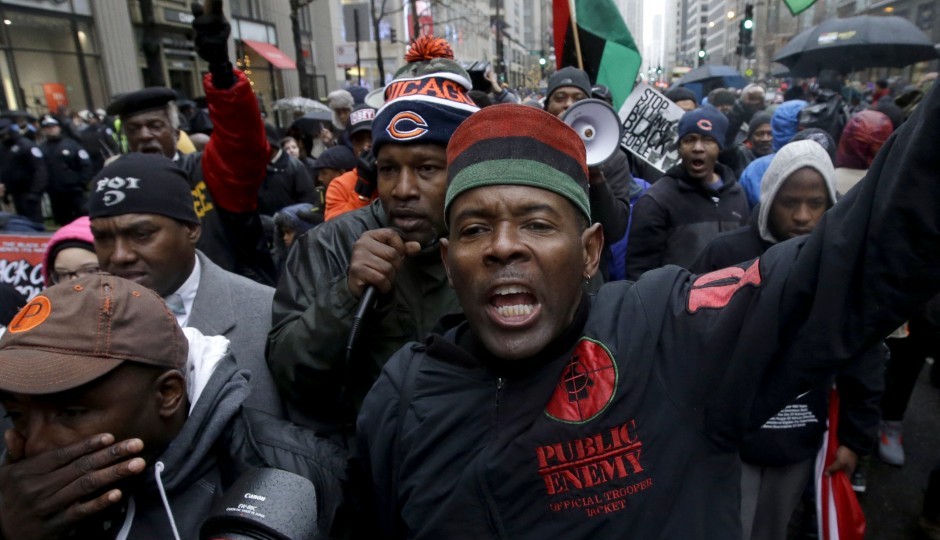Young, Black and Dead in America

Protesters make their way up North Michigan Avenue on Friday, Nov. 27, 2015, in Chicago. Community activists and labor leaders hold a demonstration in the wake of the release of video showing an officer fatally shooting Laquan McDonald. (AP Photo/Nam Y. Huh)
(Editor’s note: This is an opinion column from a Citified insider.)
According to a report conducted by the Washington Post, police have shot dead 884 people so far this year. On average, police kill more than two and a half people a day in America. That pace is up significantly over the 2014 total.
Last week, we finally learned the circumstances surrounding the fatal shooting of Chicagoan Laquan McDonald. Just 17 years old, McDonald was shot in 2014, but it wasn’t until recently, after a Freedom of Information Request filed by The Guardian was granted, that a video of the shooting was released, and the gruesome details were made clear.
Watching the video, I felt horror and then an all too familiar overwhelming wave of sadness. As a black man in America raising black sons and knowing they are seven times more likely than whites to die by police gunfire what do I tell them this time? What are the rules for not being engaged by the police? Don’t look them in the eye? Don’t pick up a toy gun in Wal-Mart? Don’t be a veteran with a history of mental illness? What exactly do you have to do to not appear to be a threat as black man in America?
My reaction was: “not again.” Not another Tamir Rice, Walter Scott, Samuel Dubose, Jonathan Ferrell or Eric Garner. As the Post wrote:
“Video shot by bystanders or captured on police camera, meanwhile, has served in some cases to undermine trust in police. So far this year, three officers have been charged with crimes after fatally shooting unarmed black men. All three were caught on video. One — the April shooting of Eric Harris in Tulsa — appears to have been an accident. But in the other two, the footage contradicted the officer’s initial account of what happened.” – Washington Post “Black and Unarmed”
And then there are the fatalities with no clear video record of the fateful moment: Freddie Gray, Michael Brown, Brandon Tate-Brown and literally hundreds of others, whose deaths are all but ignored.
I don’t pretend to understand the complexity of the enormous responsibilities of a police officer. I don’t know what they have to confront every day, or the challenge of identifying what is a threat, and what is not. The overwhelming majority of police officers perform admirably in a job that is difficult and dangerous. Like the rest of you, I can only watch the videos — when they exist — and reach my own conclusions. In the video of Mr. McDonald it appears that the only threat in that situation was to that young man’s life that ended that night.
As we’re left to ponder once again the fatal shooting of another young black man and the systems and procedures that conspired to keep the details of McDonald’s shooting a secret, you have to wonder what we’re doing right here at home in Philadelphia. What system do we have here to ensure transparency and accountability?
In July, Police Commissioner Charles Ramsey decided as departmental policy to identify police officers who have shot civilians within 72 hours. This was in line with recommendations from the Department of Justice and President Obama’s policing task force, which Ramsey chaired. Said Ramsey:”We’re public servants. I don’t think you can reasonably expect to shoot people and remain anonymous.” To many, that seemed like a commonsense way to increase transparency in the wake of police shootings.
In September, however, State Representative Martina White, with the support of the city’s police union introduced a bill that would block that release until after the incident is fully investigated. The FOP’s concern is the safety of the officer involved. The commissioner’s office has indicated there’s been no retaliation against officers involved in shootings since the department began releasing their names.
In pushing for this policy, are we seeking to create a solution for a problem that doesn’t exist? Are we creating additional barriers and opportunities for mistrust between the police department and the communities that they serve? The biggest outrage in the fatal shooting of Laquan McDonald is that for over 400 days there was very little information available on what actually happened that night. In this case, every possible effort was made to suppress the release of the graphic video. It wasn’t until after the video was ordered to be released by a judge that the Cook County prosecutor’s feel compelled to file criminal charges in the death of Mr. McDonald. When has more transparency and openness ever been a hindrance to creating and open, fair and accountable process? The fractured state of relations between police and the community demand this as a minimum.
The review process doesn’t solve everything, nor does Commissioner Ramsey’s policy. The Brandon Tate-Brown case for example, revealed huge disparities between eyewitness accounts, the officers testimony and video footage. But making that footage available and the process open is the right thing to do. It is appropriate behavior for restoring faith and trust in a system that many in our communities have very little in.
Mustafa Rashed is the President & CEO of Bellevue Strategies, a government relations, advocacy and consulting firm. He is Chairman of Friends of Doug Oliver, PAC, and he was the campaign manager of Oliver’s recent mayoral run.